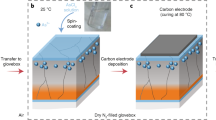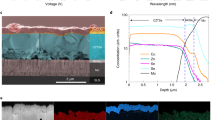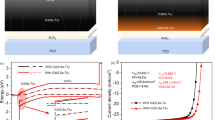Abstract
CdTe-based solar technology has achieved one of the lowest levelized costs of electricity among all energy sources as well as state-of-the-art field stability. Yet, there is still ample headroom to improve. For decades, mainstream technology has combined fast CdTe deposition with a CdCl2 anneal and Cu doping. The resulting defect chemistry is strongly compensated and limits the useful hole density to ~1014 cm−3, creating a ceiling for fill factor, photovoltage and efficiency. In addition, Cu easily changes energy states and diffuses spatially, creating a risk of instabilities that must be managed with care. Here, we demonstrate a significant shift by doping polycrystalline CdSexTe1 − x and CdTe films with As while removing Cu entirely from the solar cell. The absorber majority-carrier density is increased by orders of magnitude to 1016–1017 cm−3 without compromising the lifetime, and is coupled with a high photocurrent greater than 30 mA cm−2. We demonstrate pathways for fast dopant incorporation in polycrystalline thin films, improved stability and 20.8% solar cell efficiency.
This is a preview of subscription content, access via your institution
Access options
Access Nature and 54 other Nature Portfolio journals
Get Nature+, our best-value online-access subscription
$29.99 / 30 days
cancel any time
Subscribe to this journal
Receive 12 digital issues and online access to articles
$119.00 per year
only $9.92 per issue
Buy this article
- Purchase on Springer Link
- Instant access to full article PDF
Prices may be subject to local taxes which are calculated during checkout






Similar content being viewed by others
Data availability
The data that support the plots within this article are available from the authors upon reasonable request.
References
Luque, A. & Hegedus, S. (eds) in Handbook of Photovoltaic Science and Engineering Ch. 13, 14 (Wiley, 2011).
Liu, M., Johnston, M. B. & Snaith, H. J. Efficient planar heterojunction perovskite solar cells by vapour deposition. Nature 501, 395–398 (2013).
Antunez, P. D., Bishop, D. M., Luo, Y. & Haight, R. Efficient kesterite solar cells with high open-circuit voltage for applications in powering distributed devices. Nat. Energy 2, 884–890 (2017).
Kranz, L. et al. Doping of polycrystalline CdTe for high-efficiency solar cells on flexible metal foil. Nat. Commun. 4, 2306 (2013).
Mahabaduge, H. P. et al. High-efficiency, flexible CdTe solar cells on ultra-thin glass substrates. Appl. Phys. Lett. 106, 133501 (2015).
Reese, M. O. et al. Increasing markets and decreasing package weight for high-specific-power photovoltaics. Nat. Energy 3, 1002–1012 (2018).
Chen, S., Walsh, A., Gong, X. G. & Wei, S. H. Classification of lattice defects in the kesterite Cu2ZnSnS4 and Cu2ZnSnSe4 earth-abundant solar cell absorbers. Adv. Mater. 25, 1522–1539 (2013).
Wei, H. et al. Dopant compensation in alloyed CH3NH3PbBr3 – xClx perovskite single crystals for gamma-ray spectroscopy. Nat. Mater. 16, 826–833 (2017).
Marfaing, Y. Self compensation in II–VI semiconductors. Prog. Cryst. Growth Character. 4, 317–343 (1981).
Stanbery, B. J. Copper indium selenides and related materials for photovoltaic devices. Crit. Rev. Solid State Mater. Sci. 27, 73–117 (2002).
Krasikov, D. & Sankin, I. Defect interactions and the role of complexes in the CdTe solar cell absorber. J. Mater. Chem. A 5, 3503–3513 (2017).
Feldman, D., Hoskins, J. & Margolis, R. Q4 2017/Q1 2018 Solar Industry Update, NREL/PR-6A20-71493 (NREL, 2018); https://www.nrel.gov/docs/fy18osti/71493.pdf
Lazard’s Levelized Cost of Energy Analysis – Version 11.0; https://www.lazard.com/media/450337/lazard-levelized-cost-of-energy-version-110.pdf
Gloeckler, M., Sankin, I. & Zhao, Z. CdTe solar cells at the threshold to 20% efficiency. IEEE J. Photovolt. 3, 1389–1393 (2013).
Green, M. A. et al. Solar cell efficiency tables (version 52). Prog. Photovolt. 26, 427–436 (2017).
Kanevce, A., Reese, M. O., Barnes, T. M., Jensen, S. A. & Metzger, W. K. The roles of carrier concentration and interface, bulk and grain-boundary recombination for 25% efficient CdTe solar cells. J. Appl. Phys. 121, 214506 (2017).
Steiner, M. A. et al. Optical enhancement of the open-circuit voltage in high quality GaAs solar cells. J. Appl. Phys. 113, 123109 (2013).
Duenow, J. & Metzger, W. K. Back-surface recombination, electron reflectors and paths to 28% efficiency for thin-film photovoltaics: a CdTe case study. J. Appl. Phys. 125, 053101 (2019).
Burst, J. M. et al. CdTe solar cells with open-circuit voltage breaking the 1 V barrier. Nat. Energy 1, 16015 (2016).
Zhao, Y. et al. Monocrystalline CdTe solar cells with open-circuit voltage over 1 V and efficiency of 17%. Nat. Energy 1, 16067 (2016).
Metzger, W. K. et al. Time-resolved photoluminescence studies of CdTe solar cells. J. Appl. Phys. 94, 3549–3555 (2003).
Major, J. D., Treharne, R. E., Phillips, L. J. & Durose, K. A low-cost non-toxic post-growth activation step for CdTe solar cells. Nature 511, 334–337 (2014).
Moseley, J. et al. Luminescence methodology to determine grain-boundary, grain-interior and surface recombination in thin-film solar cells. J. Appl. Phys. 124, 113104 (2018).
Amarasinghe, M. et al. Obtaining large columnar CdTe grains and long lifetime on nanocrystalline CdSe, MgZnO or CdS layers. Adv. Energy Mater. 8, 1702666 (2018).
Gessert, T. A. et al. Dependence of carrier lifetime on Cu-contacting temperature and ZnTe:Cu thickness in CdS/CdTe thin film solar cells. Thin Solid Films 517, 2370–2373 (2009).
Wu, X. et al. Phase control of CuxTe film and its effects on CdS/CdTe solar cell. Thin Solid Films 515, 5798–5803 (2007).
Moore, A., Song, T. & Sites, J. Improved CdTe solar cell performance with an evaporated Te layer before the back contact. MRS Adv. 2, 3195–3201 (2017).
Mao, D., Wickersham, C. E. & Gloeckler, M. Measurement of chlorine concentrations at CdTe grain boundaries. IEEE J. Photovolt. 4, 1655–1658 (2014).
Harvey, S., Teeter, G., Moutinho, H. R. & Al-Jassim, M. M. Direct evidence of enhanced chlorine segregation at grain boundaries in polycrystalline CdTe thin films via three‐dimensional TOF‐SIMS imaging. Prog. Photovolt. 23, 838–846 (2015).
Major, J. D. et al. In-depth analysis of chloride treatments for thin-film CdTe solar cells. Nat. Commun. 7, 13231 (2016).
Mao, D., Blatz, G., Wickersham, C. E. Jr. & Gloeckler, M. Correlative impurity distribution analysis in cadmium telluride (CdTe) thin-film solar cells by ToF-SIMS 2D imaging. Sol. Energy Mater. Sol. Cells 157, 65–73 (2016).
Perrenoud, J. et al. A comprehensive picture of Cu doping in CdTe solar cells. J. Appl. Phys. 114, 174505 (2013).
Kuciauskas, D. et al. The impact of Cu on recombination in high voltage CdTe solar cells. Appl. Phys. Lett. 107, 243906 (2015).
Burst, J. et al. Carrier density and lifetime for different dopants in single-crystal and polycrystalline CdTe. APL Mater. 4, 116102 (2016).
Ma, J., Wei, S.-H., Gessert, T. A. & Chin, K. K. Carrier density and compensation in semiconductors with multiple dopants and multiple transition energy levels: case of Cu impurities in CdTe. Phys. Rev. B 83, 245207 (2011).
Yang, J. H., Metzger, W. K. & Wei, S. H. Carrier providers or killers: the case of Cu defect in CdTe. Appl. Phys. Lett. 111, 042106 (2017).
Grecu, D. & Compaan, A. D. Photoluminescence study of Cu diffusion and electromigration in CdTe. Appl. Phys. Lett. 75, 361–363 (1999).
Grecu, D., Compaan, A. D., Young, D., Jayamaha, U. & Rose, D. H. Photoluminescence of Cu-doped CdTe and related stability issues in CdS/CdTe solar cells. J. Appl. Phys. 88, 2490–2496 (2000).
Gretener, C. et al. New, perspective on the performance stability of CdTe solar cells. Sol. Energy Mater. Sol. Cells 146, 51–57 (2016).
Dobson, K. D., Fisher, I. V., Hodes, G. & Cahen, D. Stability of CdTe/CdS thin-film solar cells. Sol. Energy Mater. Sol. Cells 62, 295–325 (2000).
Corwine, C. R., Pudov, A. O., Gloeckler, M., Demtsu, S. H. & Sites, J. R. Copper inclusion and migration from the back contact in CdTe solar cells. Sol. Energy Mater. Sol. Cells 82, 481–489 (2004).
Albin, D. S. Accelerated stress testing and diagnostic analysis of degradation in CdTe solar cells. In Proceedings of SPIE 7048, Reliability of Photovoltaic Cells, Modules, Components, and Systems, 70480N (SPIE, 2008).
First Solar Series 6 Module Datasheet. First Solar http://www.firstsolar.com/-/media/First-Solar/Technical-Documents/Series-6-Datasheets/Series-6-Datasheet.ashx (2019).
Marfaing, Y. Impurity doping and compensation mechanisms in CdTe. Thin Solid Films 387, 123–128 (2001).
Pautrat, J. L., Francou, J. M., Magnea, N., Molva, E. & Saminadayar, K. Donors and acceptors in tellurium compounds; the problem of doping and self-compensation. J. Cryst. Growth 72, 194–204 (1985).
Selim, F. A. & Kröger, F. A. The defect structure of phosphorus-doped CdTe. J. Electrochem. Soc. Solid State Sci. Technol. 124, 401–408 (1977).
Baron, T., Tatarenko, S., Saminadayar, K., Magnea, N. & Fontenille, J. Plasma nitrogen doping of ZnTe, Cd1 – xZnxTe and CdTe by molecular beam epitaxy. Appl. Phys. Lett. 65, 1284–1286 (1994).
Tatarenko, S. et al. Nitrogen doping of Te-based II–VI compounds. J. Cryst. Growth 175/176, 682–687 (1997).
Fahrenbuch, A. L. Ohmic contacts and doping of CdTe. Sol. Cells 21, 399–412 (1987).
Duenow, J. et al. Relationship of open-circuit voltage to CdTe hole concentration and lifetime. IEEE J. Photovolt. 6, 1641–1644 (2016).
Nagaoka, A., Kuciauskas, D., McCoy, D. & Scarpulla, M. A. High p-type doping, mobility and photocarrier lifetime in arsenic-doped CdTe single crystals. Appl. Phys. Lett. 112, 192101 (2018).
Chu, T. L., Chu, S. S., Ferekides, C., Britt, J. & Wu, C. Q. Thin-film junctions of cadmium telluride by metalorganic chemical vapor deposition. J. Appl. Phys. 71, 3870 (1992).
Berrigan, R. A., Maugn, N., Irvine, S. J. C., Cole-Hamilton, D. J. & Ellis, D. Thin films of CdTe/CdS grown by MOCVD for photovoltaics. J. Cryst. Growth 195, 718–724 (1998).
Proskuryakov, Y. Y. et al. Doping levels, trap density of states and the performance of co-doped CdTe(As,Cl) photovoltaic devices. Sol. Energy Mater. Sol. Cells 93, 1572–1581 (2009).
Kartopu, G. et al. Study of thin film poly-crystalline CdTe solar cells presenting high acceptor concentrations achieved by in-situ arsenic doping. Sol. Energy Mater. Sol. Cells 194, 259–267 (2019).
McCandless, B. E. et al. Overcoming carrier concentration limits in polycrystalline CdTe thin films with in-situ doping. Sci. Rep. 8, 14519 (2018).
Romeo, N., Bosio, A. & Rosa, G. The back contact of CdTe/CdS thin film solar cells. In Proc. ISES Solar World Congress 2017 (International Solar Energy Society, 2017); http://proceedings.ises.org/paper/swc2017/swc2017-0130-Romeo.pdf
Colegrove, E. et al. Experimental and theoretical comparison of Sb, As and P diffusion mechanisms and doping in CdTe. J. Phys. D Appl. Phys. 51, 075102 (2018).
Guthrey, H. et al. Spatial luminescence imaging of dopant incorporation in CdTe Films. J. Appl. Phys. 121, 45304 (2017).
Colegrove, E. et al. Phosphorus diffusion mechanisms and deep incorporation in polycrystalline and single-crystalline CdTe. Phys. Rev. Appl. 5, 054014 (2016).
Bhargava, R. (ed.) Properties of Wide Bandgap II–VI Semiconductors (INSPEC, 1997).
Fiducia, T. A. M. et al. 3D distributions of chlorine and sulphur impurities in a thin-film cadmium telluride solar cell. MRS Adv. 3, 3287–3292 (2018).
Ablekim, T. et al. Self-compensation in arsenic doping of CdTe. Sci. Rep. 7, 4563 (2017).
O’Connor, D. V. & Phillips, D. Time-Correlated Single Photon Counting (Academic Press, 1984).
Metzger, W. K., Romero, M. J., Dippo, P. & Young, M. Characterizing recombination in CdTe solar cells with time-resolved photoluminescence. In Proc. 2006 IEEE 4th World Conference on Photovoltaic Energy Conference 372–375 (IEEE, 2006).
Metzger, W. K., Ahrenkiel, R. K., Dashdorj, J. & Friedman, D. J. Analysis of charge separation dynamics in a semiconductor junction. Phys. Rev. B 71, 03530 (2005).
Gaury, B. & Haney, P. M. Charged grain boundaries reduce the open-circuit voltage of polycrystalline solar cells. J. Appl. Phys. 120, 234503 (2016).
Ablekim, T., Colegrove, E. & Metzger, W. K. Interface engineering for 25% CdTe solar cells. ACS Appl. Energy Mater. 1, 5135–5139 (2018).
Gloeckler, M., Sites, J. R. & Metzger, W. K. Grain boundary recombination in Cu(In,Ga)Se2 solar cells. J. Appl. Phys. 98, 113704 (2005).
Metzger, W. K. & Gloeckler, M. The impact of charged grain boundaries on thin-film solar cells and characterization. J. Appl. Phys. 98, 063701 (2005).
Moseley, J. et al. Recombination by grain-boundary type in CdTe. J. Appl. Phys. 118, 025702 (2015).
Scheer, R. Activation energy of heterojunction diode currents in the limit of interface recombination. J. Appl. Phys. 105, 104505 (2009).
Perkins, C. L., Beall, C., Reese, M. O. & Barnes, T. M. Two-dimensional cadmium chloride nanosheets in CdTe solar cells. ACS Appl. Mater. Interfaces 9, 20561 (2017).
Werner, J. H., Mattheis, J. & Rau, U. Efficiency limitations of polycrystalline thin film solar cells: case of Cu(In,Ga)Se2. Thin Solid Films 480, 399–409 (2005).
Jensen, S. A. et al. Beneficial effect of post-deposition treatment in high-efficiency Cu(In,Ga)Se2 solar cells through reduced potential fluctuations. J. Appl. Phys. 120, 063106 (2016).
Casey, H. C. & Stern, F. Concentration-dependent absorption and spontaneous emission of heavily doped GaAs. J. Appl. Phys. 47, 631–643 (1976).
Munroe, P. R. The application of focused ion beam microscopy in the material sciences. Mater. Charact. 60, 2–13 (2009).
Abou-Ras, D., Nichterwitz, M., Romero, M. J. & Schmidt, S. S. in Advanced Characterization Techniques for Thin Film Solar Cells (eds Abu-Ras, D., Kirchatz, T. & Rau, U.) 312–318 (Wiley, 2011).
Perkins, C. L. Molecular anchors for self-assembled monolayers on ZnO: a direct comparison of the thiol and phosphonic acid moieties. J. Phys. Chem. C 113, 18276–18286 (2009).
Nonnenmacher, M., O’Boyle, M. P. & Wickramasinghe, H. K. Kelvin probe force microscopy. Appl. Phys. Lett. 56, 2921–2923 (1991).
Kikukawa, A., Hosaka, S. & Imura, R. Silicon pn junction imaging and characterizations using sensitivity enhanced Kelvin probe force microscopy. Appl. Phys. Lett. 66, 3510–3512 (1995).
Jiang, C.-S., Moutinho, H. R., Friedman, D. J., Geisz, J. F. & Al-Jassim, M. M. Measurement of built-in electrical potential in III-V solar cells by scanning Kelvin probe microscopy. J. Appl. Phys. 93, 10035–10040 (2003).
Acknowledgements
The authors thank P. Dippo for low-temperature photoluminescence measurements. This work was authored in part by the National Renewable Energy Laboratory, operated by the Alliance for Sustainable Energy, LLC, for the US Department of Energy under contract no. DE-AC36- 08GO28308. Funding was provided by the US Department of Energy Office of Energy Efficiency and Renewable Energy Solar Energy Technologies Office and CRD-13-507. The views expressed do not necessarily represent the views of the US Department of Energy or the US Government.
Author information
Authors and Affiliations
Contributions
S.G., E.C., X.L., R. Mallick, W.Z., R. Malik, J.K. and D.S.A. performed film and device synthesis as well as J–V, J–V versus temperature, EQE and C–V measurements. S.G., D.K., J.M., C.L.P., C.-S.J. and M.M.A. performed photoluminescence, TRPL, CL, XPS, KPFM and STEM measurements. W.K.M., D.L., G.X. and M.G. directed the research. All authors contributed to the design and interpretation of experiments and writing the manuscript.
Corresponding author
Ethics declarations
Competing interests
S.G., D.L., X.L., R. Mallick, W.Z., R. Malik, J.K., G.X. and M.G. work at First Solar, which is a publicly traded company that manufactures CdTe solar panels and develops grid-connected photovoltaic power plants. Outside of this and the funding listed in the acknowledgments section, the authors declare no competing interests.
Additional information
Publisher’s note: Springer Nature remains neutral with regard to jurisdictional claims in published maps and institutional affiliations.
Supplementary information
Supplementary Information
Supplementary Figs. 1–2.
Rights and permissions
About this article
Cite this article
Metzger, W.K., Grover, S., Lu, D. et al. Exceeding 20% efficiency with in situ group V doping in polycrystalline CdTe solar cells. Nat Energy 4, 837–845 (2019). https://doi.org/10.1038/s41560-019-0446-7
Received:
Accepted:
Published:
Issue Date:
DOI: https://doi.org/10.1038/s41560-019-0446-7
This article is cited by
-
Modelling and Optimization of “n–i–p” Structured CdS/MASnI3/CdTe Solar Cell with SCAPS-1D for Higher Efficiency
Journal of Electronic Materials (2024)
-
Highly Crystalline and Stoichiometric Growth of CdTe by Cost-Effective Hydrothermal Technique
Journal of Electronic Materials (2024)
-
Impact of electrical and optical parameters on performance of CdTe solar cell with a-Si as a hole transport layer
Journal of Optics (2023)
-
Single-source thermal evaporation converts anion controllable Sb2(S,Se)3 film for fabricating high-efficiency solar cell
Science China Materials (2023)
-
Optimization of CdS-free non-toxic electron transport layer for Sb2S3-based solar cell with notable enhanced performance
Journal of Computational Electronics (2023)



